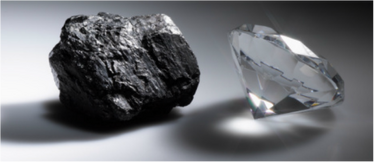
Black lead and diamond, two well-known kinds of sheer coalshaft.
Coalshaft (English: Carbon) is the sixth of the shafts; its token is C. The shaftmotes of coalshaft hold six ekemotes and six levenmotes and, most often, six evenmotes. Coalshaft is unorelike, and its shaftmotes most often make four bonds with other shaftmotes, for which thing coalshaft can, with other shafts, make a great manifold of bindshafts, which are the building stitches of life. The lore of these is called lifeworthy blendlore.
Coalshaft comes in two abiding evenstows, 12C and 13C, but 13C is much more geason. Even more geason still is 14C, which is beamsprind with a halflife of 5,730 years. When a living thing dies, its 14C halts its eftnewing, and dwindles as the anwork gets older. Herethrough, loremasters can find the eld of wood, bone, and other once-living anwork.
Sheer coalshaft comes in sundry kinds; among these are black lead and diamond. In black lead, the shaftmotes lie in loosely-bound sheets; the heart of a leadfeather is made of black lead, and when it is dragged along the leaf, the black lead is sloughed off to make the writer's marks. In diamond, each shaftmote is bonded to four others in a tidy shape, so that the stone is swith hard and stiff. No other kindful antimber is harder than diamond, which is brooked as both a fair arkenstone and for drillbits and sharp cutting edges.
Coalshaft gets its name from coal, in which it is the main building-stitch. Coal is burnt for heat and to drive steam gearworks, along with lifeworthy bindshafts rich in coalshaft, such as wax and wood. When burnt, whether in the outer lift or in the inner fire that drives living beings, coalshaft bonds with sourshaft to make wortlift (CO2). Wortlift, in turn, is taken up by worts, which free its sourshaft and brook its coalshaft in the making of new lifeworthy bindshafts, so that the loop can begin anew.